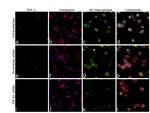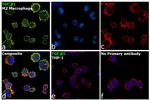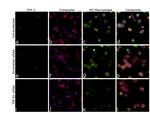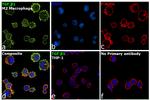Search Thermo Fisher Scientific
Invitrogen
TGF beta-1 Monoclonal Antibody (TB21)
This Antibody was verified by Knockdown to ensure that the antibody binds to the antigen stated.
FIGURE: 1 / 5
TGF beta-1 Antibody (MA5-18023) in ICC/IF





Product Details
MA5-18023
Species Reactivity
Published species
Host/Isotype
Class
Type
Clone
Immunogen
Conjugate
Form
Concentration
Purification
Storage buffer
Contains
Storage conditions
Shipping conditions
RRID
Product Specific Information
This antibody reacts with the dimeric (25 kDa) and monomeric (12.5 kDa) forms of TGF-beta under both non-reducing and reducing conditions. In ELISA applications, this antibody recognizes both human platelet-derived and recombinant TGF-beta.
This antibody neutralizes TGF-beta activity in vitro in an inhibition assay of CCL/64 cell growth, and neutralizes the growth promoting action of TGF-beta in the NRK-49F colony forming assay. The effect of microinjection of this antibody into one blastomere of two cell stage Xenopus embryos indicated that it was able to neutralize effectively the bioactivity of TGF-beta in vivo.
In IHC applications, this antibody has been used to demonstrate TGF-beta in ovine ovarian tissue and human breast carcinoma. As a consequence of the intense staining of the erythrocytes, it is possible to locate a single cell within the ovarian stroma making it useful in locating very fine capillary networks within tissue.
Target Information
TGF beta-1 (TGFB1, Transforming Growth Factor Beta 1) is a polypeptide member of the transforming growth factor beta superfamily of cytokines, found almost ubiquitously in tissues. Transforming growth factor (TGF)-b is stored in the extracellular matrix as a latent complex with its pro-domain. Activation of TGF beta-1 requires the binding of aV integrin to an RGD sequence in the prodomain and exertion of force on this domain, which is held in the extracellular matrix by latent TGF-b binding proteins. Latent forms are complexes of TGF beta-1, an amino-terminal portion of the TGF-beta precursor, designated TGF-LAP (TGF-latency associated peptide), and a specific binding protein, known as LTBP. TGF beta-1 helps regulates proliferation, differentiation, adhesion, migration in many cell types. Many cells have TGF beta receptors, and the protein positively and negatively regulates many other growth factors. TGF beta-1 is cleaved into a latency-associated peptide and a mature TGF beta-1 peptide, and is found in either a latent form composed of a TGFB1 homodimer, a LAP homodimer, and a latent TGFB1-binding protein, or in an active form composed of a TGF beta-1 homodimer. The mature peptide may also form heterodimers with other TGF beta family members. The gene for TGF beta-1 is frequently upregulated in tumor cells, and mutations in this gene result in Camurati-Engelmann disease and cystic fibrosis.
For Research Use Only. Not for use in diagnostic procedures. Not for resale without express authorization.
Bioinformatics
Protein Aliases: latency-associated peptide; prepro-transforming growth factor beta-1; regulatory protein; TGF b; TGF b 1; TGF beta; tgf beta 1; TGF beta-1; TGF beta-1 protein; tgf beta1; TGF β; TGF β 1; TGF β1; TGF-B1; TGF-beta 1; TGF-beta 1 protein; TGF-beta-1; TGFβ1; Transforming growth factor; transforming growth factor b1; transforming growth factor beta; transforming growth factor beta-1; Transforming growth factor beta-1 proprotein; transforming growth factor β1; transforming growth factor, beta 1 (Camurati-Engelmann disease); transforming growth factor, beta-1; transforming growth factor-beta 1; transforming growth factor-beta-1 precursor
Gene Aliases: CED; DPD1; LAP; TGF-beta1; TGFB; Tgfb-1; TGFB1; TGFbeta; TGFbeta1
UniProt ID: (Human) P01137, (Bovine) P18341, (Sheep) P50414, (Rat) P17246, (Mouse) P04202
Entrez Gene ID: (Human) 7040, (Rabbit) 100008645, (Bovine) 282089, (Sheep) 443417, (Rat) 59086, (Mouse) 21803

Performance Guarantee
If an Invitrogen™ antibody doesn't perform as described on our website or datasheet,we'll replace the product at no cost to you, or provide you with a credit for a future purchase.*
Learn more
We're here to help
Get expert recommendations for common problems or connect directly with an on staff expert for technical assistance related to applications, equipment and general product use.
Contact tech support
